
Born: 14 November 1840, Paris
Died: 5 December 1926 (aged 86)
Period: Impressionism
The Life of Claude Monet
Claude Monet was a foundational figure in the Impressionist movement, known for his devotion to capturing the transient effects of light and color in the natural world. Born in Paris and raised in Le Havre, Monet showed early talent in art, particularly in drawing. His initial artistic efforts were caricatures, but a meeting with Eugène Boudin introduced him to painting en plein air (outdoors), a practice that would fundamentally shape his future work.
In the late 1850s, Monet moved to Paris to pursue his art, studying at the Académie Suisse. His early work reflected the influence of the Barbizon school and included realistic depictions of everyday life. However, his style evolved as he sought to capture the momentary and sensory effects of a scene, focusing on landscapes, seascapes, and scenes from modern life.
Monet’s involvement in the 1874 exhibition of the Anonymous Society of Painters, Sculptors, Printmakers, etc., where the term “Impressionism” originated from the title of his painting “Impression, Sunrise” (1872), solidified his role as a leader in this new art movement. Impressionism challenged traditional approaches to art, emphasizing spontaneous, loose brushwork and a brighter palette to capture the “impression” of a moment.
Throughout his career, Monet experimented with the effects of light and shadow, famously painting the same scene multiple times at different times of day and in varying weather conditions to capture the changing atmospheres. His series of paintings, such as those of the Rouen Cathedral, haystacks, poplars, and water lilies, are celebrated for their exploration of perception, time, and the experience of nature.
Monet’s later years were marked by personal tragedy, including the death of his second wife, Alice, and his own struggles with cataracts. Despite these challenges, he continued to paint, creating some of his most famous and innovative works, including the large-scale water lily murals designed for the Orangerie in Paris. These late works, characterized by their free form and almost abstract quality, have been seen as precursors to modernist art.
Monet lived the last decades of his life in Giverny, where he cultivated a magnificent garden that served as the inspiration for his water lily series. His home and garden in Giverny have become a place of pilgrimage for art lovers and remain a testament to his lifelong commitment to exploring the interplay of light, color, and nature.
Monet’s legacy is immense, not only in the development of Impressionism but also in influencing the course of 20th-century art. His dedication to capturing fleeting moments of natural beauty opened new possibilities for artistic expression and continues to inspire admiration and study.
Claude Monet’s Notable Works
Claude Monet, a pioneer of Impressionism, is celebrated for his exploration of light and color through landscape and outdoor scenes. His extensive body of work left a profound impact on the course of modern art. Here are ten of Monet’s most famous and significant works, each illustrating his innovative approach to capturing moments in time:
- Impression, Sunrise (1872) – The painting that gave Impressionism its name, this depiction of a sunrise over the port of Le Havre is famous for its vibrant colors and loose brushwork, capturing the essence of the moment rather than the details.
- Water Lilies series (1896-1926) – Monet’s extensive series of water lily paintings, created in his garden at Giverny, are among his most famous works, celebrated for their abstract quality and exploration of light and reflection on the pond’s surface.
- Woman with a Parasol – Madame Monet and Her Son (1875) – This portrait of his wife, Camille, and their son, Jean, captures a fleeting moment in time with dynamic brushstrokes and a vibrant depiction of light and shadow.
- The Japanese Bridge (1899) – Part of a series depicting the wooden bridge over the pond in his Giverny garden, this painting is renowned for its bold composition and harmonious interplay of color and light.
- Rouen Cathedral series (1892-1894) – Monet painted the façade of Rouen Cathedral at different times of day and in different weather conditions, exploring the changing effects of light on its surface.
- Haystacks series (1890-1891) – This series showcases Monet’s fascination with the changing seasons and times of day, capturing the haystacks in various atmospheric conditions with varying colors and shadows.
- The Gare Saint-Lazare (1877) – One of a series depicting the busy train station in Paris, this painting reflects Monet’s interest in modern life and his ability to capture the steam and energy of the industrial age.
- The Artist’s Garden at Giverny (1900) – This vibrant depiction of his own garden at Giverny showcases Monet’s mastery of color and his ability to transform a landscape into a harmonious, natural artwork.
- San Giorgio Maggiore at Dusk (1908-1912) – Part of his Venice series, this painting captures the ethereal beauty of the Venetian island at dusk, with subtle color shifts and reflections on the water.
- Poplars series (1891) – This series of poplar trees along the Epte River near Giverny explores the rhythmic patterns of nature and the effects of light and air through the changing seasons.
Monet’s work exemplifies the Impressionist movement’s core principles, emphasizing the importance of light, color, and the artist’s perception in capturing the essence of a subject. His innovative techniques and dedication to painting en plein air revolutionized the art world, making him one of the most celebrated artists in history.